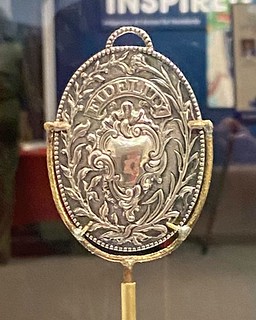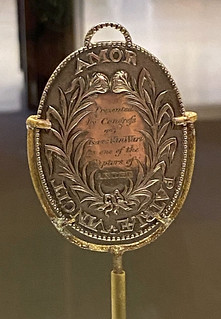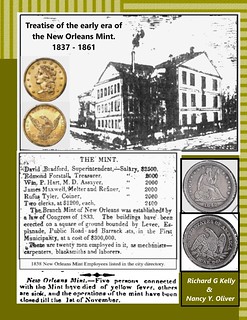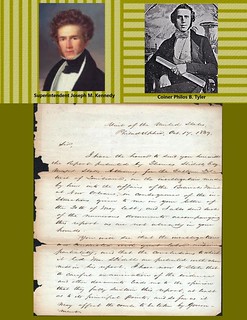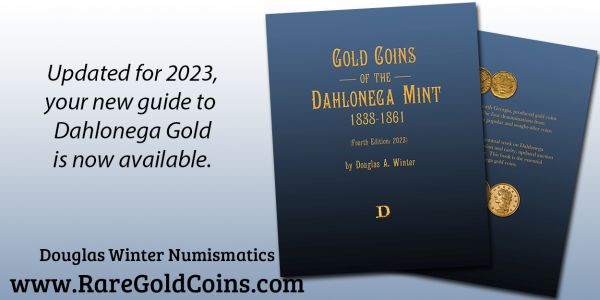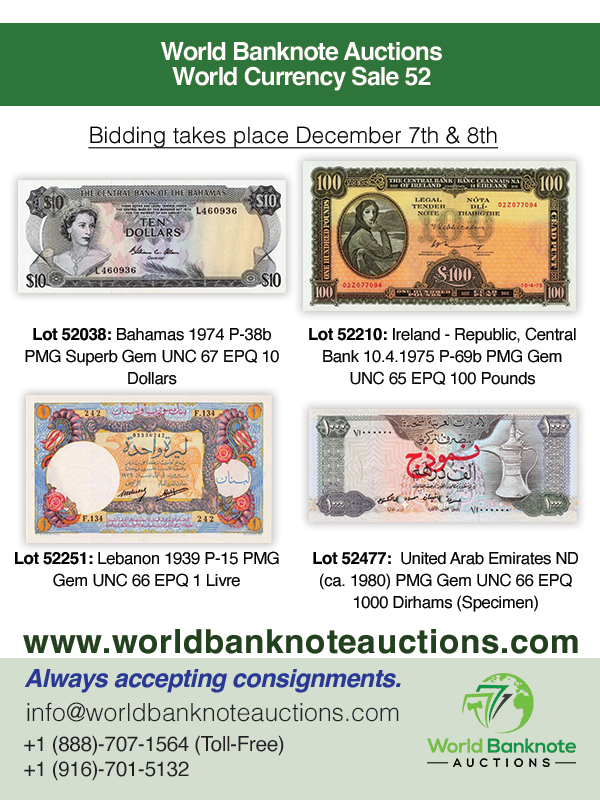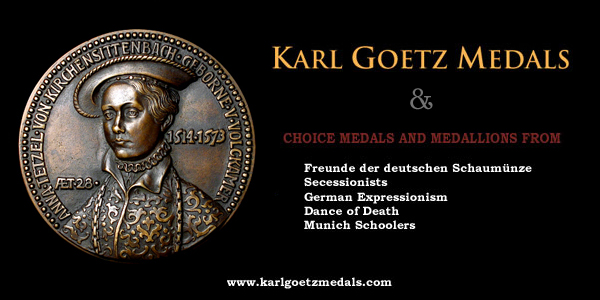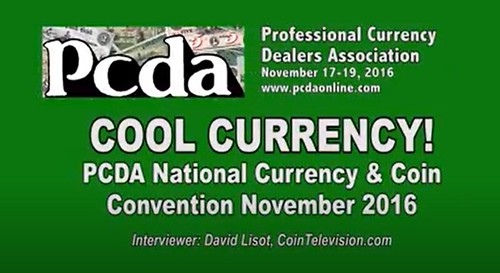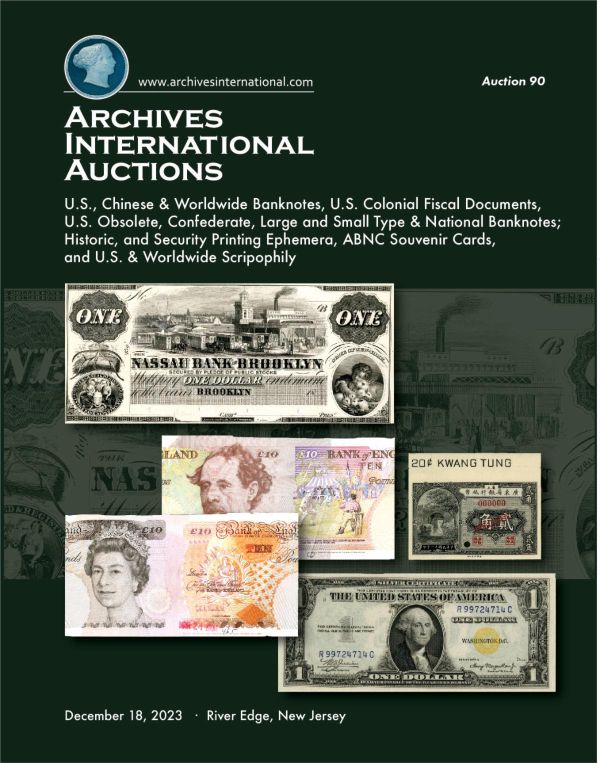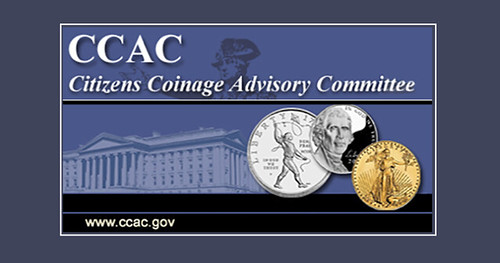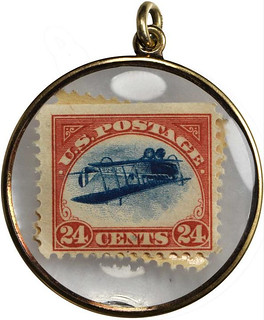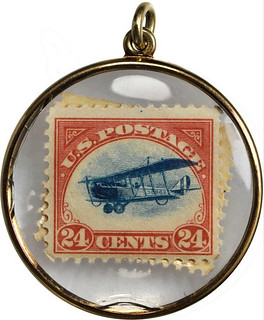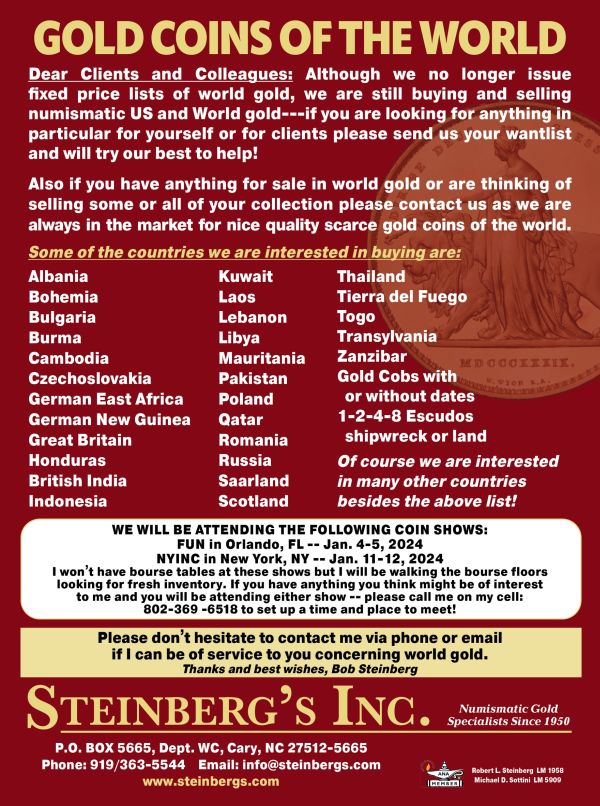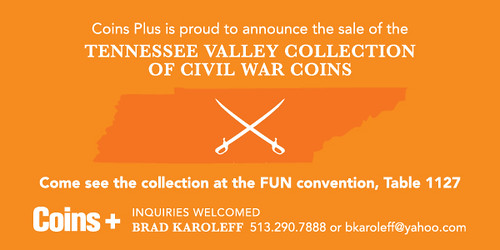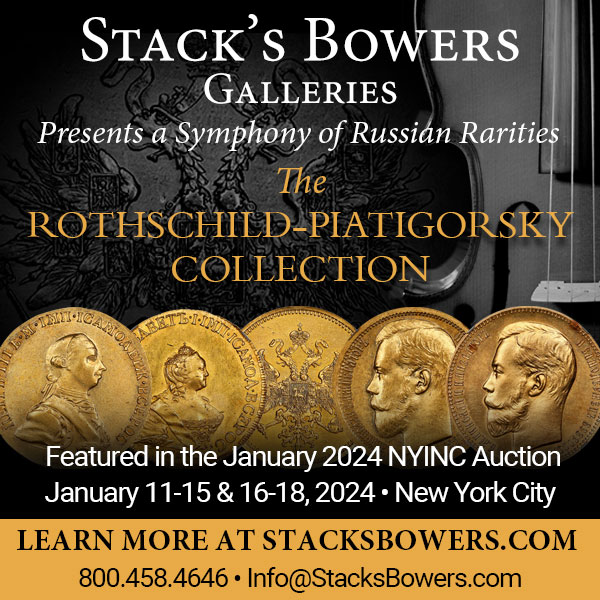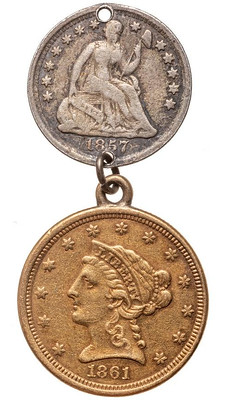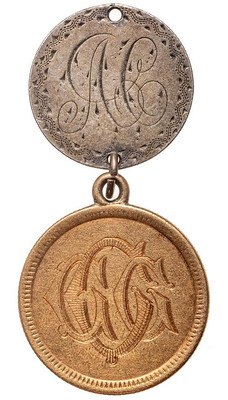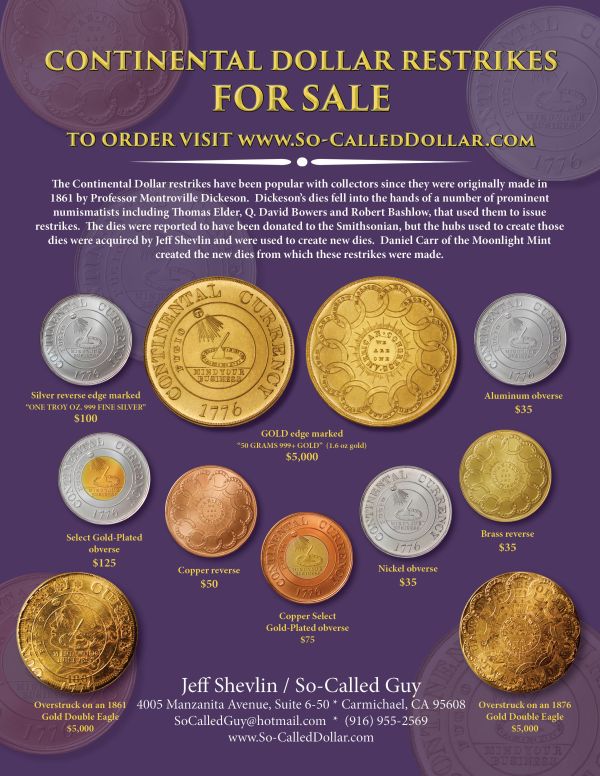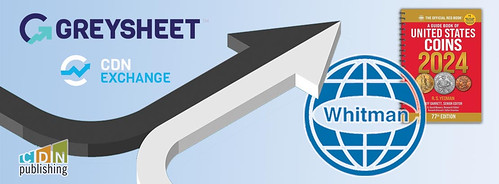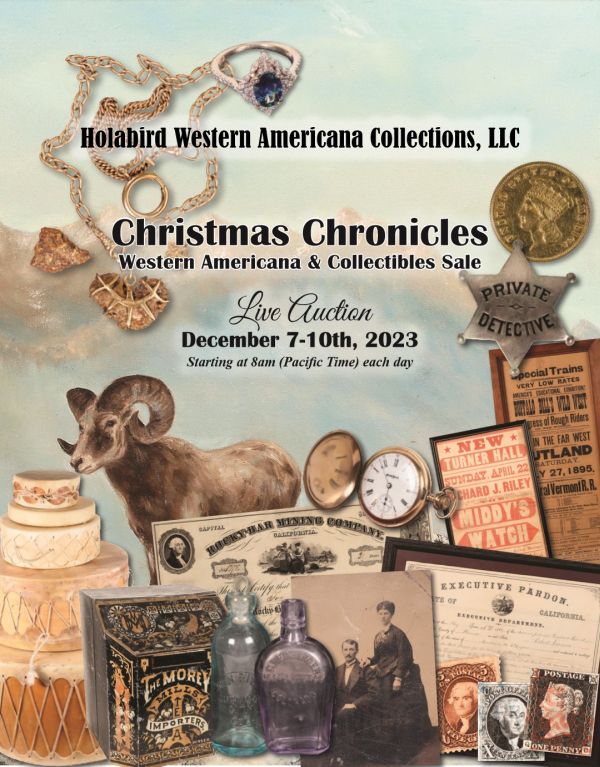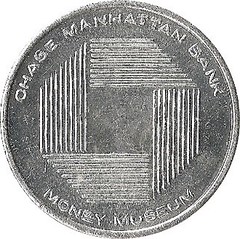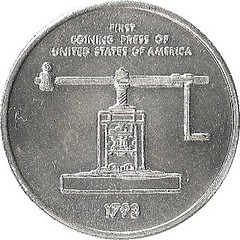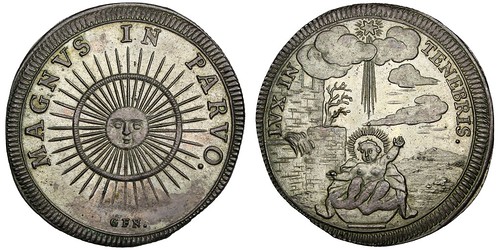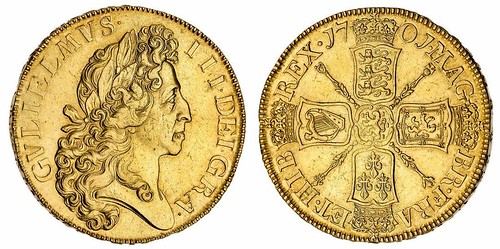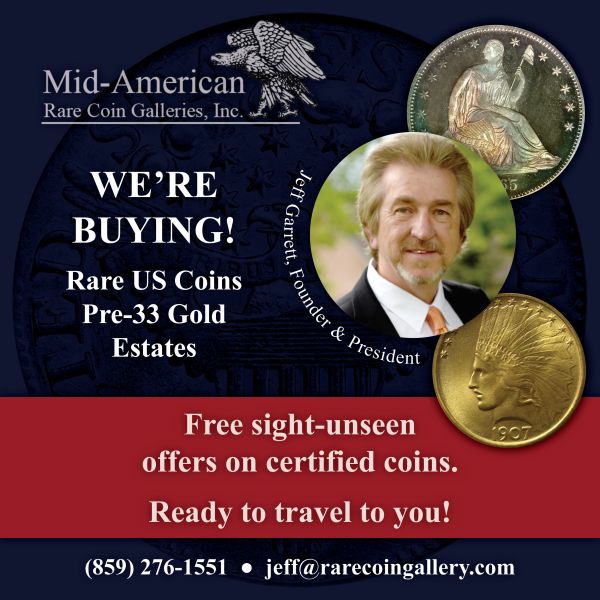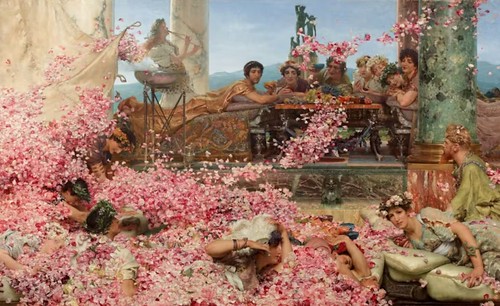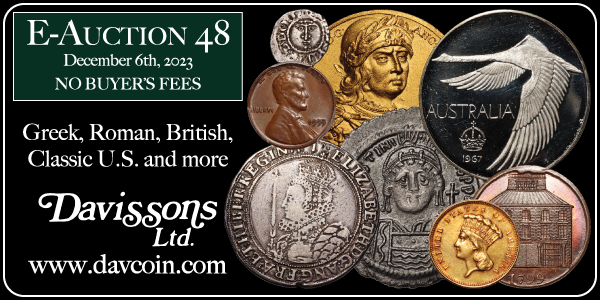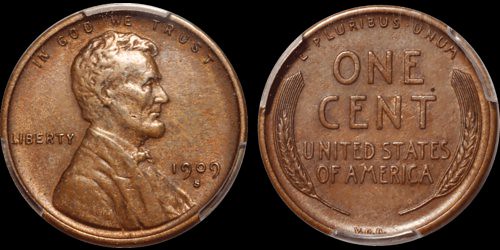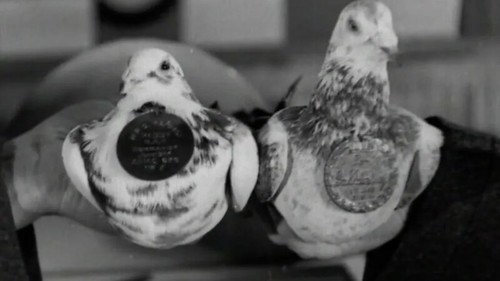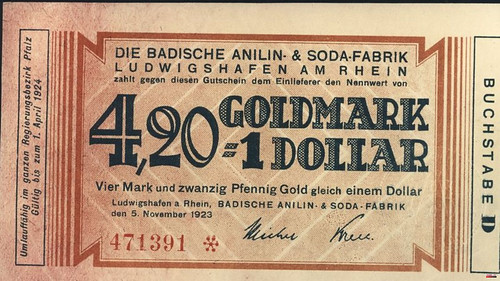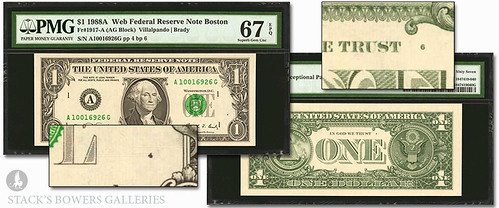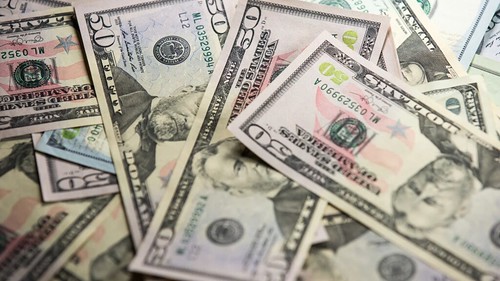
Visit our NBS Sponsors




About UsThe Numismatic Bibliomania Society is a non-profit association devoted to the study and enjoyment of numismatic literature. For more information please see our web site at coinbooks.org SubscriptionsThose wishing to become new E-Sylum subscribers (or wishing to Unsubscribe) can go to the following web page link MembershipThere is a membership application available on the web site Membership Application To join, print the application and return it with your check to the address printed on the application. Print/Digital membership is $40 to addresses in the U.S., and $60 elsewhere. A digital-only membership is available for $25. For those without web access, write to: Jeff Dickerson, Treasurer AsylumFor Asylum mailing address changes and other membership questions, contact Jeff at this email address: treasurer@coinbooks.org SubmissionsTo submit items for publication in The E-Sylum, write to the Editor at this address: whomren@gmail.com BUY THE BOOK BEFORE THE COINSale Calendar |
- WAYNE'S WORDS: THE E-SYLUM DECEMBER 3, 2023
- KUNZE'S 1800 COIN COLLECTION DESCRIPTION
- NEW BOOK: EARLY ERA OF THE NEW ORLEANS MINT
- NEW BOOK: SESTERCES DES ANTONINS - IV (96-192)
- NEW BOOK: COINAGE IN IMPERIAL SPACE
- PERIODICAL: NUMISMATIQUE ASIATIQUE NO. 47
- NNP ADDS NOVEMBER 2023 SYMPOSIUM VIDEOS
- VIDEO: 2016 PCDA CURRENCY CONVENTION
- CCAC SEEKS MEDALLIC ARTS APPLICANTS
- THE INVERTED JENNY LOCKET
- NOTES FROM E-SYLUM READERS: DECEMBER 3, 2023
- FIDELITY MEDAL AT THE NEW YORK STATE MUSEUM
- SILVER AND GOLD COIN LOVE TOKEN JEWELRY
- VOCABULARY TERMS: OVERDATE, OVERDATING
- WHITMAN PUBLISHING, PAST AND FUTURE
- MONEY MUSEUMS IN THE U.S., PART ONE
- MONEY MUSEUMS IN THE U.S., PART TWO
- DAVID SCHENKMAN INTERVIEW, PART FIVE
- NUMISMAGRAM MEDAL SELECTIONS: DECEMBER 3, 2023
- ANS CANADIAN TOKEN SALE
- NUMISMATIC NUGGETS: DECEMBER 3, 2023
- MORE ON ROMAN EMPEROR ELAGABALUS
- THE CLASSIC LINCOLN CENT
- DICKIN MEDAL 80TH ANNIVERSARY
- DENVER MINT SILVER INGOT OFFERED
- THE ANILINE DOLLAR
- WHAT IS A WEB NOTE?
- A RECORD NUMBER OF $50 BILLS
- LOOSE CHANGE: DECEMBER 3, 2023
- COIN MAGICIAN NICOLE CARDOZA
Content presented in The E-Sylum is not necessarily researched or independently fact-checked, and views expressed do not necessarily represent those of the Numismatic Bibliomania Society.
WAYNE'S WORDS: THE E-SYLUM DECEMBER 3, 2023
 Thank you for reading The E-Sylum. If you enjoy it, please send me the email addresses of friends you think may enjoy it as well and I'll send them a subscription. Contact me at whomren@gmail.com anytime regarding your subscription, or questions, comments or suggestions about our content.
Thank you for reading The E-Sylum. If you enjoy it, please send me the email addresses of friends you think may enjoy it as well and I'll send them a subscription. Contact me at whomren@gmail.com anytime regarding your subscription, or questions, comments or suggestions about our content.
This week we open with a rare publication of the contents of an early coin collection in the U.S., three new books, a periodical, updates from the Newman Numismatic Portal, and more.
Other topics this week include notes from readers, Love Token jewelry, overdates, money museums in the U.S., fixed price and auction sales, the classic Lincoln Cent, the Dickin Medal, silver ingots, web notes, and coin magic.
To learn more about John C. Kunze's coin collection, the early New Orleans Mint, Una and the Lion, the CCAC, the Inverted Jenny Locket, the Fogg Museum coin robbery, the Van Wart Fidelity Medal exhibit, Whitman Publishing, the Tammany Society Museum, Communion tokens, Emperor Elagabalus, analine dollars, and the coins of future economic powerhouses, read on. Have a great week, everyone!
Wayne Homren
Editor, The E-Sylum
KUNZE'S 1800 COIN COLLECTION DESCRIPTION
In an online bookstore listing, Kolbe & Fanning Booksellers offer a copy of the only published 18th-century account of a coin collection formed by an American. -Editor
DESCRIPTION OF A CABINET OF COINS AND MEDALS ANCIENT AND MODERN.
Kunze, John C.
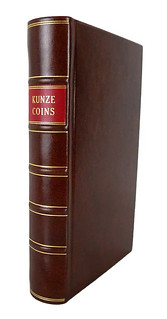 The Medical Repository. Volume III (New York: Printed by T. & J. Swords, 1800). Conducted by Samuel L. Mitchill and Edward Miller. 8vo, modern full brown speckled calf; spine with five raised bands, ruled in gilt; red morocco spine label, gilt. 7, (1), 428 pages [Kunze's article is on pages 351–359]. Some spotting. Near fine in a fine binding. Item #7218
The Medical Repository. Volume III (New York: Printed by T. & J. Swords, 1800). Conducted by Samuel L. Mitchill and Edward Miller. 8vo, modern full brown speckled calf; spine with five raised bands, ruled in gilt; red morocco spine label, gilt. 7, (1), 428 pages [Kunze's article is on pages 351–359]. Some spotting. Near fine in a fine binding. Item #7218
John C. Kunze's 1800 description of his coin collection, possibly the only 18th-century account of a coin cabinet formed by an American collector. Kunze's little-known article, written in the form of a letter to Dr. Samuel Mitchill though intended for publication, is one of the very few detailed portrayals of coin collecting in the early days of the Republic. Kunze (1744–1807) was a Lutheran minister and professor. Having studied at the University of Leipzig, he moved to Philadelphia in 1770, married, and established the Lutheran Theological Seminary. The pastor of Zion Lutheran Church, he served as a member of the Board of trustees of the University of the State of Pennsylvania, where he also served as a professor of languages and philology. He later moved to New York, where he served the Trinity and Christ Church and taught Oriental languages at Columbia. In addition to his religious and scholarly activities, Kunze studied medicine and astronomy, and was the official translator for Congress in 1785.
NEW BOOK: EARLY ERA OF THE NEW ORLEANS MINT
Numismatic Researchers Richard Kelly & Nancy Oliver have made a compilation of research material on the early New Orleans Mint available on NNP. Here's their announcement. Thank you! -Editor
Treatise of the Early Era of the New Orleans Mint 1837-1861
by Richard G. Kelly, Nancy Y. Oliver
This is our contribution to Newman's Numismatic Portal online. It is a treatise of the history of the early years of the New Orleans Mint from 1837 until the takeover by the Confederacy in 1861. The work is taken from the many thousands of copies made of Mint Record Group 104 by two noted numismatic researchers, Robert Julian and Roger Burdette, and archivists at the National Archives in Philadelphia and College Park, Maryland.
It is 75 pages long and contains information about the building, employees and coinage. Put together chronologically, and noted from hand written letters (many hard to decipher) from mint officials and others, it took two years to complete. Some years' info has been gleaned from other Portal sources and contemporary newspapers from the period when copies from the archives were not accomplished. However, a recent surge of copies from these sparse years noted is now coming available, and this will require a future update and revision of this said work. This will take some time.
NEW BOOK: SESTERCES DES ANTONINS - IV (96-192)
Laurent Schmitt passed along notice of a new volume in a series on the sestertius of the Antonines. Thank you. It can be ordered directly from the author or online at CGB Numismatics, where I found this English description. -Editor
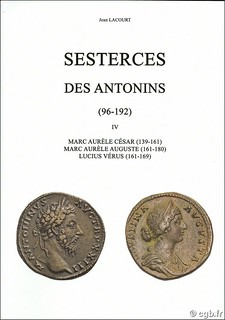 Sesterces des Antonins - IV (96-192)
Sesterces des Antonins - IV (96-192)
Marc Aurèle César (139-161) - Marc Aurèle Auguste (161-180) - Lucius Vérus (161-169)
by Jean Lacourt
The present work, the fourth of a series of 5 volumes devoted to the sestertius of the Antonines, covers the reigns of Marcus Aurelius Caesar (139-161), Marcus Aurelianus Augustus (161-180) and Lucius Verus (161-169).
Intended for both amateurs and professionals, it is designed as a practical tool to facilitate the recognition of these coins. Indeed, it is not a classical catalog or a historical and chronological study, but a key allowing the very fast and sure identification of these sestertius. Contrary to the method usually used in numismatics, this key, of new conception, starts with the precise study of the obverse, and ends with its coding. To this obverse code will then be grafted and merged one or more reverse codes.
For each type of sestertius, the reference works are cited, followed by an inventory of their presence in most of the world sales of the last 12 years, allowing the reader to better appreciate their degree of rarity. This key is illustrated by more than 800 photographs of obverse and reverse.
NEW BOOK: COINAGE IN IMPERIAL SPACE
The December 2023 ANS eNews from the American Numismatic Society announced a new volume of conference papers. -Editor
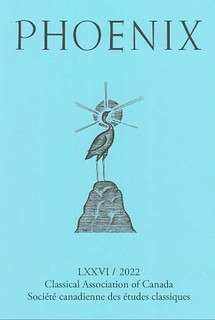 Coinage in Imperial Space: Coins in the Economy of the Achaemenid and Early Hellenistic World: Conference Papers in Phoenix
Coinage in Imperial Space: Coins in the Economy of the Achaemenid and Early Hellenistic World: Conference Papers in Phoenix
Papers from the 2017 conference in Krakow, Poland will be published in volume 76 of Phoenix, a journal of the Classical Association of Canada. The conference was organized by the Institute of Archaeology of the Jagiellonian University, the Faculty of Classics at the University of Oxford, and the National Museum in Krakow. Authors in the conference report include Peter van Alfen (ANS Chief Curator), Jonathan Kagan (ANS Trustee), and Andrew Meadows (former ANS Deputy Director). To purchase, contact phoenix@utoronto.ca.
PERIODICAL: NUMISMATIQUE ASIATIQUE NO. 47
Here are the contents of the latest issue of Numismatique Asiatique. -Editor
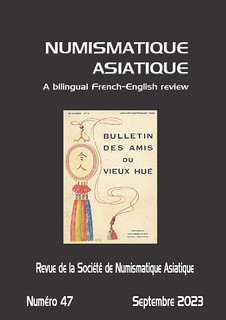 EDITORIAL
EDITORIAL
About the forgeries offered on the numismatic market
ANNAM
The Bài Plaques Used in Vietnam during the Nguy?n Dynasty
by Craig Greenbaum
CENTRAL ASIA
Apropos of coins with the legend zhou-yuan tong-bao from finds in Kyrgyzstan
by V. A. Belyaev, S. V. Sidorovich
LAOS
THE BOOK BAZARRE
NNP ADDS NOVEMBER 2023 SYMPOSIUM VIDEOS
The latest additions to the Newman Numismatic Portal are videos of the latest NNP Symposium. Project Coordinator Len Augsburger provided the following report. -Editor
NNP Symposium Video Posted
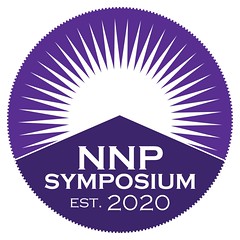 Video from the NNP Symposium, held November 2-4, 2023, is now posted. Our feature presentation, Treasures of the ANA Museum, began with the debut of an NNP-produced video on the subject, followed by American Numismatic Association Museum Curator Doug Mudd answering viewer questions on various aspects of the collection. In other presentations, Bill Eckberg presented new photographs of the enigmatic 1792 Judd-6 Birch cent, a coin last seen at the 1981 Garrett sale. Patrick McMahon spoke on Anna Powell Jones and Rebecca Salisbury, two early U.S. numismatists, while Bob Bair provided an overview of the famed
Video from the NNP Symposium, held November 2-4, 2023, is now posted. Our feature presentation, Treasures of the ANA Museum, began with the debut of an NNP-produced video on the subject, followed by American Numismatic Association Museum Curator Doug Mudd answering viewer questions on various aspects of the collection. In other presentations, Bill Eckberg presented new photographs of the enigmatic 1792 Judd-6 Birch cent, a coin last seen at the 1981 Garrett sale. Patrick McMahon spoke on Anna Powell Jones and Rebecca Salisbury, two early U.S. numismatists, while Bob Bair provided an overview of the famed Una and the Lion
coinage. Other sessions focused on various aspects of U.S. and world coins and paper money.
The NNP Symposium, sponsored by the Newman Numismatic Portal, was launched in the fall of 2020 in response to the pandemic. This free event is Zoom-based and draws presenters from all areas of numismatics. The recent event represented the seventh Symposium. As always, many thanks to our speakers, and for those who are interested in presenting at a future event, please contact NNPCurator@wustl.edu.
VIDEO: 2016 PCDA CURRENCY CONVENTION
The David Lisot Video Library on the Newman Numismatic Portal can be found at:
https://nnp.wustl.edu/library/multimediadetail/522852
We highlight one of his videos each week in The E-Sylum. Here's one about the 2016 PCDA Currency Convention -Editor
CCAC SEEKS MEDALLIC ARTS APPLICANTS
The U.S. Mint is seeking applicants for an open seat on the Citizens Coinage Advisory Committee (CCAC). Here's the press release. -Editor
as the Member Specially Qualified in Medallic Arts or Sculpture
The United States Mint is seeking applicants for an appointment to the Citizens Coinage Advisory Committee (CCAC) as the member specially qualified to serve on the advisory body by virtue of their education, training, or experience in the medallic arts or sculpture. The deadline to email submissions is no later than 5 p.m. (ET) on Wednesday, January 3, 2024. The United States Mint will review all applications and forward recommendations to the Secretary of the Treasury for consideration.
THE INVERTED JENNY LOCKET
Last week I asked about the whereabouts of the locket containing an "Inverted Jenny" stamp given by Col. E.H.R. Green to his wife Mabel. -Editor
Julia Casey writes:
"The Inverted Jenny Locket was sold by Stack's in 2015 - to an anonymous coin collector! "
NOTES FROM E-SYLUM READERS: DECEMBER 3, 2023
George Kolbe on Coin-A-Rama City
George Kolbe writes:
"From 1962 to 1968 I lived in Redondo Beach, not that far away from Coin-A-Rama City. I was a regular visitor. I sold coins on the bid board and occasionally rented a bourse table on Wednesdays. What an amazing hub of numismatic wheeling and dealing it was.
"My wife Linda and I were good friends with Eileen Lawson. Eileen was a major force in Southern California coin clubs and numismatic organizations and conventions. She was smart as a whip and selfless in devotion to promoting her chosen hobby. She died fairly young and deserves far more credit than generally accorded her.
"In later years I visited Coin-A-Rama City a time or two. The magic was gone."
Thanks - it's great to get these first-person accounts from people who were there. -Editor
To read the earlier E-Sylum article, see:
COIN-A-RAMA CITY
(https://www.coinbooks.org/v26/esylum_v26n47a18.html)
Other topics this week include Harvey Richer and Tom DeLorey. -Editor
FIDELITY MEDAL AT THE NEW YORK STATE MUSEUM
Julia Casey visited the display of the Van Wart Fidelity Medal at the New York State Museum, and provided this report. Thank you! -Editor
It was a brisk late fall day when I traveled to the New York State Museum in Albany to see the Van Wart Fidelity Medal. The museum is located across Madison Avenue, on the south side of the Empire State Plaza. Here is the view from the entrance with the Corning Tower and The Egg.
The New York State Capitol, with the red roof, is in the distance.
The museum is free to enter (donations requested) and there is a small parking lot available at $10 a day – or free after 2 pm. When I arrived, this lot was full, so I used my wiles to finagle street parking. I lived in this area of Albany when I went to law school, and I parked on a familiar side street (free for 2 hours).
SILVER AND GOLD COIN LOVE TOKEN JEWELRY
I found this earlier this week for the Numismatic Nuggets article, but I reached out to Love Token expert Carol Bastable, and she shared additional information for readers. Thanks! -Editor
1861 $2.50 Love Token with reverse nicely engraved CGC. Cannot tell which reverse because of the engraving. 1857 half dime seems to be engraved AC on reverse. 1861 in bezel, 1857 has two small holes and both connected with loop
Most Love Tokens are singles, but are sometimes seen in multiples as part of bracelets and other jewelry items. This one is the first I recall seeing with coins of two different metals. -Editor
VOCABULARY TERMS: OVERDATE, OVERDATING
Here's another entry from Dick Johnson's Encyclopedia of Coin and Medal Terminology. -Editor
Overdate, Overdating. One or more numerals on a die reworked by punches or re-engraved to change the date to a later – or correct – year. Overdating is of two kinds: to correct a punch anomaly where an incorrect punch was used (or the correct one upside down, for instance), or to extend the life of a usable die by permitting it to be retained in use and changing the date to a proper year. It is accomplished by annealing, softening the die and overpunching with the correct punch in the proper location. The depth of the punching is reason for obliterating the under figure and for a slightly raised figure in the struck piece.
WHITMAN PUBLISHING, PAST AND FUTURE
A Greysheet article by Patrick Ian Perez discusses the recent CDN Publishing acquisition of Whitman Publishing, and mentions an interesting piece of Whitman history I'd overlooked or forgotten about. -Editor
As the title of this column is The Business of Numismatics, I usually try and cover the latest in the wider rare coin market. As the year 2023 closes, the biggest news in numismatics happens to hit much closer to home. As many readers may have heard, CDN Publishing (parent of the Greysheet) has acquired the historic and important Whitman Publishing in November.
First, some history. Western Printing Company was first established in Racine, Wisconsin in 1907, and by 1910 was a successful venture. In 1916, Western took over a bankrupt Hamming-Whitman publishing company, and it was decided to adopt the Whitman name as a subsidiary. Western Publishing remained the parent company, and there is no doubt there are many readers who have seen this imprint on the backs of early example of the distinct dark blue coin folders that defined an entire generation of collectors. In addition to coin books and supplies, Western Publishing produced famous lines of children's books, including the Little Golden books.
MONEY MUSEUMS IN THE U.S., PART ONE
E-Sylum Feature Writer and American Numismatic Biographies author Pete Smith submitted this wonderful compilation of Money Museums in the United States, past and present. Thanks! Here's the first of two parts. An amazing list - while I was at least somewhat familiar with most of these, there are a number I'd missed or forgotten about. Very useful.
Have you visited any of the obsolete museums? Please share your experience with us. -Editor
The concept of a money museum is broadly applied here. It may be a building devoted entirely to that museum. It may be a small section of a larger museum or a numismatic division in a university library. It might be in the back room of a coin store. Some museums offer virtual exhibits and some may be entirely virtual.
MONEY MUSEUMS IN THE U.S., PART TWO
E-Sylum Feature Writer and American Numismatic Biographies author Pete Smith submitted this wonderful compilation of Money Museums in the United States, past and present. Here's the second and final part. An amazing list - while I was at least somewhat familiar with most of these, there are a number I'd missed or forgotten about. Very useful.
Have you visited any of the obsolete museums? Please share your experience with us. -Editor
Nebraska
Boy's Town Philamatic Center. Boys Town was first located in the former home of Byron Reed in Omaha, Nebraska. The Philamatic center opened on July 1, 1951. Although the emphasis is on stamps, they also show numismatic material. Mel Stark, curator 1960-1979. Leo J. Eckert, curator 1979-1984, D. O. Barrett, curator.
Durham Museum. Omaha, Nebraska. Featuring the Byron Reed Collection. The exhibit was mounted by curator Dr. Larry Lee. [Open]
Nevada
Bellagio Hotel, Las Vegas. When I visited the Bellagio Hotel in 2005, they had a money museum with an admission charge. I was unwilling to pay the price of admission.
Columbus Industries, Inc., Reno. Nevada. announced the opening of a money museum in 1988. They were a coin dealer and auction company. The museum was not mentioned again.
Nevada State Museum, Carson City. The museum is in the Carson City Mint building and includes an exhibit of Carson City coinage and some mint equipment. [Open]
New Jersey
Princeton University Library, Numismatic Collection. Louis West, curator after 1944. Alan Stahl, curator after 2004.
New York
American Numismatic Society, Manhattan, New York. Located in Audubon Terrace, Broadway and West 155th in 1904. Moved to Fulton and William Street in 2003. Moved again in 2008 to 75 Varick Street. The collection includes an estimated 800,000 objects. [Currently Active]
Barnum's American Museum, New York City. Broadway and Ann Street. Owned by P. T. Barnum who acquired Scudder's American Museum in 1841. The Museum was destroyed by fire on July 13, 1865.
Chase Manhattan Bank Money Museum, Rockefeller Center, Manhattan, New York. The collection was formed by Farran Zerbe who created temporary exhibits at world's fairs and expositions; the museum was established in 1929, closed in 1973; donated to the Smithsonian Institution. Vernon Brown, curator, retired in 1963. Gene Hessler, curator 1967-1973.
Museum of American Finance, 48 Wall Street, Manhattan. Affiliated with the Smithsonian Institution. Exhibits include stocks and bonds but do not include coins or paper money. The building was damaged by flooding in 2018 but the exhibits survived.
New-York Historical Society. 170 Central Park West, New York City. Founded in 1804, they claim to be New York's oldest museum. That is a statement to which the Tammany Society Museum might take exception. They acquired the John C. Kunze collection from his widow in 1818. A few years later, the collection was stolen, leaving only the empty cabinet. Recently, in 2013, they had the 1933 Double Eagle on display there. {Currently Active]
Riley's Fifth Ward Museum Hotel, New York City. 94 Broadway. Formed by Thomas Tiley. Opened in 1826. The collection was sold at auction in 1864.
Tammany Society Museum, New York City. Situated in the Exchange building in 1793. Collection formed by Gardner Baker. It included several hundred coins and medals. On April 20, 1796, a glass case was broken and silver coins were taken, the second theft from the museum. This made Baker the first victim of a numismatic theft in America. [Closed]
North Carolina
Mint Museum, Charlotte, North Carolina. Despite its name, this is an art museum without numismatic exhibits.
Ohio
Federal Reserve Bank of Cleveland, Learning Center and Money Museum, Superior and East Sixth Street, Cleveland, Ohio. Closed September 11, 2001; reopened on January 3, 2005. [Currently Active]
Western Museum, Cincinnati. Opened in 1820 as a natural science museum. It included coins on exhibit. [Closed]
Pennsylvania
American Philosophical Society, American Museum. Pierre Eugene Du Simitiere was owner and curator 1776 to 1781. After his 1784 death, the contents of the museum were sold by a 1785 broadside in what may be the first American auction of a coin collection.
First Bank of the United States, Philadelphia. The building is undergoing a 22.2 million dollar renovation project. It is scheduled to reopen as a money museum in 2026.
Independence National Historical Park. Congress Hall. Frank Stewart transferred the
Old Mint Collection
to Congress Hall on October 22, 1914, with the understanding that the
collection would be exhibited indefinitely. Some items were transferred to the Fourth
Philadelphia Mint in 1969.
Peale's Philadelphia Museum, Philadelphia. Established by Charles Willson Peale. Situated on the second floor of Independence Hall in 1802. The Peale family sold the museum in 1849. [Closed]
Philadelphia Mint, Mint Cabinet. Adam Eckfeldt established the Mint cabinet in 1838, setting aside coinage returned to the Mint and restriking coins missing from the collection. The Mint created an exhibit with 7000 coins and 2000 medals for the Columbian Exposition. The cases were returned to Philadelphia and installed at the Mint. William Ewing DuBois, curator 1838-1881. Robert A. McClure, curator 1881-1902. T. Louis Comparette, curator 1905-1922. In 1923 the Mint Cabinet was transferred to Washington D.C. and the National Numismatic Collection. [Closed]
The Fourth Philadelphia Mint has a small exhibit area at the mezzanine level. The lobby includes the Tiffany mosaics from the Third Philadelphia Mint. The Mint has unfortunate errors interpreting the history of the Mint.
Pittsburgh, Carnegie Museum. They had, at one time, more than 200,000 coins including the Clapp large cents. William W. Woodside, curator.
Tennessee
Union Planters National Bank Money Museum, 100 North Main, Memphis, Tennessee. Opened May 1, 1969. Featuring the collection of P.(owell) B.(inford) Trotter. Helen Williams, curator.
Virginia
Federal Reserve Bank of Richmond Money Museum. Permanently closed in Spring of 2023.
Wisconsin
Fred W. Harris Money Museum, Wisconsin Dells, Wisconsin. Described as the world's largest portable money museum. Exhibited in various forms in the 1930's, it was described as more diverse than the Chase Bank Museum. Reverend Harris died in 1938. His collection was sold at auction by Bolender in 1940. [Closed]
To read the earlier E-Sylum articles, see:
SHAPERO, DODSON AND THEIR MONEY MUSEUM
(https://www.coinbooks.org/v26/esylum_v26n48a20.html)
CHASE MANHATTAN MUSEUM BRENNER EXHIBIT
(https://www.coinbooks.org/v26/esylum_v26n48a21.html)
DAVID SCHENKMAN INTERVIEW, PART FIVE
Greg Bennick's latest interview for the Newman Numismatic Portal is with token expert David Schenkman. Here's the fifth of six parts, where Dave and Greg discuss rarity and the mind of a collector. -Editor
Greg Bennick: So in terms of rarity, not necessarily connecting rarity with which might be your favorite, do you have favorite pieces that you've collected over the years. Out of all the tokens that have passed through your hands, and of course, your time writing for Numismatic News and The Numismatist and all, or are there any specific tokens that have fallen under your collection that are your standout favorites. Ones that you can think of off the top of your head that were just the ones that you remember above all others.
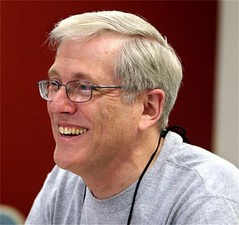 David Schenkman: We'd have to do a separate interview for that! (laughter) I think that my
favorites changed, and I think as much as anything, it depends on what I'm working on. If I'm
working on an article or a book, I tend to concentrate on that more. And maybe those are my
favorite, as I say, I tend to lose interest in something when I'm done with it. I wrote a catalog of
Civil War sutler tokens, and those were tokens used by the merchants who traveled with the
soldiers and sold goods. And I had my collection which numbered about 400 pieces. And I got
to the point that I was maybe finding one more a year because I had most of them and I lost
interest because I wasn't finding them. I think that if you're looking for something that's your
goal and when you find it, it's no longer your goal so then your goal becomes something else.
David Schenkman: We'd have to do a separate interview for that! (laughter) I think that my
favorites changed, and I think as much as anything, it depends on what I'm working on. If I'm
working on an article or a book, I tend to concentrate on that more. And maybe those are my
favorite, as I say, I tend to lose interest in something when I'm done with it. I wrote a catalog of
Civil War sutler tokens, and those were tokens used by the merchants who traveled with the
soldiers and sold goods. And I had my collection which numbered about 400 pieces. And I got
to the point that I was maybe finding one more a year because I had most of them and I lost
interest because I wasn't finding them. I think that if you're looking for something that's your
goal and when you find it, it's no longer your goal so then your goal becomes something else.
Greg Bennick: I could totally see that. And at the same time I can imagine celebrating and being so excited about the acquisition or the find that you celebrate it for a while. But there's definitely in the collector mindset, and I've talked in other interviews about the collector mindset: what makes us collectors. What is it about our brains or about our approach to the world that makes us want to acquire or appreciate numismatic items, for example? And I'm fascinated and would love to write a book, I think on just that alone, the psychology of the collector. But there's something about us that once we acquire something, we're both satisfied and then we're on to the next thing, which is seemingly what you're saying about you write the book, you've completed that thing. Okay, now what's next?
NUMISMAGRAM MEDAL SELECTIONS: DECEMBER 3, 2023
Jeremy Bostwick with Numismagram sent along these four medals from his most recent upload of new material to his site. For all of the new items, please visit https://www.numismagram.com/inventory. -Editor
102602 | GERMANY. Nürnberg. Silver Großer Kerzendreier (3 Pfennig Baptismal Token). Issued circa 1700 (27mm, 3.54 g, 12h). By G. F. Nürnberger. MAGNVS IN PARVO (mighty yet humble), facing radiant personification of the sun // LVX IN TENEBRIS (light in darkness), radiant infant Jesus Christ lying in manger; partial ruins in background to left; above, radiant Star of Bethlehem showing downward through the clouds. Fenzlein 597; Erlanger Coll. 963. Choice Mint State. Lightly toned, with great brilliance in the fields. $365.
Georg Friedrich Nürnberger was a prolific late 17th/early 18th century coiner and medalist in the city which shared his name, with baptismal-related coins, medals, and tokens serving an important role in his mint's offerings. For more wealthy families, gold ducat klippes, as well as their fractions, stood as keepsakes intended for the parents and godparents of a newly-baptised child. For those of more modest means, tokens such as this "Kerzendreier," literally "three candlesticks," possibly served a similar role. It is still not fully known if these silver issues were produced by Nürnberger's roller dies as direct gifts, similar to the gold medallic ducats, or as a pseudo-ecclesiastic medium of exchange, whereby a token could be used to purchase a candle from the church (candles being a common gift given to the child's parents and godparents). Given that the candles at the time cost 1 kreuzer (or 3 pfennig), the name of "three candlesticks" may have become the common slang, with the three indicating the 3 pfennig cost for the candlestick thus purchased.
To read the complete item description, see:
102602 | GERMANY. Nürnberg. Silver Kerzendreier (3 Pfennig Baptismal Token).
(https://www.numismagram.com/product-page/102602)
ANS CANADIAN TOKEN SALE
The ANS is selling a collection of Canadian tokens this week. Here's the press release. -Editor
Heritage Auctions Sale of Canadian Tokens to Benefit the ANS
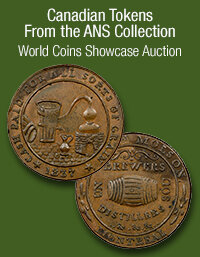 The American Numismatic Society is pleased to announce that a notable collection of 19th and 20th century Canadian tokens will be offered at a showcase auction held by Heritage Auctions on December 4, 2023, for the benefit of the Society. The tokens are all duplicates of specimens from the Society. The entire proceeds of this significant sale will go to the Newell Fund, which allows the ANS to continue acquiring important objects while also providing funds to support collections management.
The American Numismatic Society is pleased to announce that a notable collection of 19th and 20th century Canadian tokens will be offered at a showcase auction held by Heritage Auctions on December 4, 2023, for the benefit of the Society. The tokens are all duplicates of specimens from the Society. The entire proceeds of this significant sale will go to the Newell Fund, which allows the ANS to continue acquiring important objects while also providing funds to support collections management.
The auction will offer 171 lots of over one thousand Canadian tokens, with excellent specimens coming from Newfoundland, New Brunswick, Upper and Lower Canada, and the Wellington and Blacksmith series. Many of the tokens were donated by the Norweb Family – in particular Mrs. Emily May Norweb and Ambassador Raymond Henry Norweb, Sr., who were major benefactors of the ANS and contributed a large number of coins to the Society, including the famed Brasher Doubloon. Their collection of American and European coins and tokens was one of the greatest collections of the 20th century. Other tokens from the auction—some of which have been off the market for over a century—are pedigreed to several prominent Canadian numismatists, including A.B. Baird, Alfred Z. Reed, P.O. Tremblay, and W.R. Powell.
NUMISMATIC NUGGETS: DECEMBER 3, 2023
Here's a selection of interesting or unusual items I came across in the marketplace this week. Tell us what you think of some of these. -Editor
1701 William III Five-Guineas
NGC AU | William III (1694-1701), 'Fine-Work' Five-Guineas, 1701 DECIMO TERTIO, "Ornamental Sceptres" Type, second laureate head right, rev. crowned shields cruciform, ornamented sceptres in angles, + •+ DECVS • ET • TVTAMEN • ANNO • REGNI • DECIMO • TERTIO upwards on edge, 41.64g [642.60grns], 5h (MCE 172; Schneider II, 481; EGC 401; Holloway GH 62; Stratos -; King 139; Spink 3456), a small rim bruise by V of GVLIELMVS, adjustment marks to cheek and scant traces of graffito before bust, lightly wiped but residually brilliant, a handsomely bold very fine / almost extremely fine, in NGC 'St. Helier' QR holder, graded AU Details ~ Obverse Graffiti / Cleaned (Cert. #6767923-003)
From the upcoming Spink St Helier Collection of English Gold Coins sale. -Editor
To read the complete lot description, see:
NGC AU | WILLIAM III (1694-1701), 'FINE-WORK' FIVE-GUINEAS, 1701 DECIMO TERTIO, "ORNAMENTAL SCE...
(https://live.spink.com/lots/view/4-C1K4Y4/ngc-au-william-iii-1694-1701-fine-work-five-guineas-1701-decimo-tertio-ornamental-sce)
Other topics this week include a St. Louis Agricultural Medal, Communion Tokens, and Shepard Fairey's Obey Money Art. -Editor
MORE ON ROMAN EMPEROR ELAGABALUS
The Conversation is a nonprofit that recruits academics to write balanced articles getting at the truth of various topics making the rounds. This one examines the recent claim about emperor Elagabalus discussed last week. Here's an excerpt - see the complete article online. -Editor
Elagabalus ruled as Roman emperor for just four years before being murdered in AD 222. He was still a teenager when he died. Despite his short reign, Elagabalus is counted among the most infamous of Roman emperors, often listed alongside Caligula and Nero.
Based on this quote, North Hertfordshire Museum has reclassified Elagabalus as a transgender woman, and will now use the pronouns she/her. The museum has a single coin depicting Elagabalus, which is sometimes displayed along with other LGBTQ+ artefacts from their collection.
When writing about ancient subjects, from emperors to slaves, the first question historians have to ask is: how do we know what we do? Most of our written sources are fragmentary, incomplete and rarely contemporary, amounting to little more than gossip or hearsay at best, malign propaganda at worst. It's rare that we have a figure's own words to guide us.
THE CLASSIC LINCOLN CENT
In an email to clients ahead of the Davisson's E-Auction 48, Allan Davisson discussed the classic Lincoln cent. -Editor
E-Auction 48 closes next week on Wednesday, December 6th! Lots begin closing at 10 a.m. U.S. Central Time. A carefully curated 333 lots, do take a look! And read on as Allan discusses a classic starting point for countless collectors – the Lincoln cent.
In many respects, it is a humble coin, the smallest bit of change still in circulation. Though its production is seen by many as no longer necessary, the US Mint continues to provide pennies. In the first half of this year, the Philadelphia and Denver mints produced nearly a half billion of the pieces. (Canada stopped minting pennies in 2012.)
It may be humble
but it is still in demand. The pieces offered in this catalog—attractive and minty
high grade pieces including a couple of the major rarities, as well as a Whitman album (Lot 323) with all but two of the slots filled, are from a collection formed by a collector with a particular appreciation for 20th century American coins. Cataloging and offering these pieces took me back many years to my own early collecting. Fascinated as I was with pennies when I was young, I saw hardly any early coins of this caliber and I never handled a 1955/55 double-die penny until this one.
THE BOOK BAZARRE
DICKIN MEDAL 80TH ANNIVERSARY
This BBC News article on the 80th anniversary of the Dickin Medal discusses recipient Gustav, a pigeon that flew the first message back on D-Day. -Editor
A pigeon that flew the first message back on D-Day has been remembered 80 years after service animals were first officially honoured in Britain.
Gustav, from Portsmouth, flew over 150 miles (240km) in five hours and 16 minutes from the shores of Normandy to his wartime base on Thorney Island.
He received the animal equivalent of the Victoria Cross, the Dickin Medal.
It was first given on 2 December 1943 by the People's Dispensary for Sick Animals (PDSA) founder Maria Dickin.
DENVER MINT SILVER INGOT OFFERED
A January 11th, 2024 auction by Las Vegas dealer VCD Auctions offers a rare Denver Mint silver ingot. Here's an excerpt of the lot description. -Editor
The United State Denver Mint Ingot
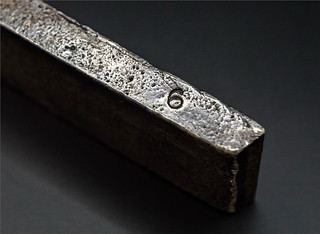 This
This Denver Ruler Ingot
, discussed here, is only the second known example of a United States Mint Denver Assay Silver Ingot. The other known Denver Assay Silver specimen is discussed below as is the one other Ruler Ingot
known which is a Mint of the United States Philadelphia piece. However, with that being said, they are far from equal as the Denver ingot is in a known total population of two (2) while there are at least fifty-five (55) Philadelphia ingots known as noted in Ken Conaway's registry. Being this specimen is not only a rare style Ruler Ingot
and in addition a silver ingot with a United States Denver Hallmark (government mintmark) shown below. This museum quality specimen is virtually the Holy Grail
of known Mint of the United States ingots. Some historians would classify the Mint of the United States Denver Ruler Ingot
as a Strip Cast Sheared Silver Ingot but according to Ken Conaway and Steve Austin it is more likely actual bar stock rolling method of production.
The first and other known example of a Denver Mint silver ingot was placed by Kagin's Incorporated in the United States Government Silver Ingot Collection of Ken Conaway.
THE ANILINE DOLLAR
In November 1923, the German company BASF introduced an emergency currency, the analine dollar. Found via News & Notes from the Society of Paper Money Collectors (Volume IX, Number 22, November 14, 2023). -Editor
As a reminder of a difficult time of crisis in Germany, it is now in the BASF corporate archives: the so-called aniline dollar. 100 years ago, in November 1923, the Ludwigshafen company introduced the emergency currency. For a few weeks the aniline dollar became a recognized and popular means of payment in the Palatinate. There are also various emergency coins in the company archives. According to the group, there is no reliable information about the whereabouts of most of the notes. BASF was founded in 1865 as Badische Aniline.
At the end of the First World War, Germany was heavily indebted and extremely high inflation put a strain on people. The government allowed companies to produce emergency money to pay wages and maintain trade. The BASF plumbing company began producing blanks from zinc sheet metal. From January 1, 1918 to June 6, 1919, the company issued 64,290 marks to its employees. As security, the management had to deposit 165,000 marks in Prussian treasury notes with the Bavarian State Bank.
WHAT IS A WEB NOTE?
Stack's Bowers Currency Auction Associate Bradley C. Trotter published an article about the experimental U.S. Federal Reserve web notes. -Editor
For all intents and purposes, a Web Note is just like any other modern $1 note, but with one key difference. Printed from May 1992 to November 1996, Web Notes are distinguishable from normal $1 notes by the modified position of the front and back plate numbers. Although subtle, the quickest way to discern a Web Note is by the presence of a plate number on the reverse to the right of In God we Trust
and the removal of the check letter-number on the face which was substituted with a single plate number.
This change in design was precipitated by the introduction of the experimental Web Process by the Bureau of Engraving & Printing to streamline the production of $1 notes. Using printers reminiscent of those used in the production of newspapers, the hope was to reduce the time for printing $1s, which at the time constituted just over half of the Bureau's workload. In theory, the Web Process would have eliminated the need for four intaglio sheet-fed presses and the labor requirements of the old process.
A RECORD NUMBER OF $50 BILLS
Pablo Hoffman passed along this CNN article about the $50 bill. Thanks. -Editor
Unless you're an avid currency collector, an employee of the Bureau of Engraving and Printing, or work at the Federal Reserve, you likely didn't know that last year a record number of $50 bills were printed.
Last year, the government printed 756,096,000 of those bills — the highest total of the denomination printed in one year in more than 40 years. If you put all those $50s together, you'd have about $37.8 billion.
LOOSE CHANGE: DECEMBER 3, 2023
Here are some additional items in the media this week that may be of interest. -Editor
Leon Saryan passed along this article about additional finds from the Maravillas wreck. -Editor
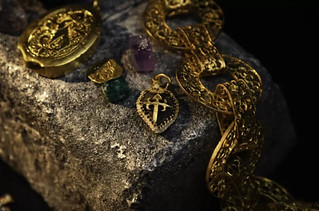 Experts thought the 17th-century Spanish galleon—known as the Nuestra Señora de las Maravillas (meaning "Our Lady of Wonders")—had been "salvaged into oblivion", Sean Kingsley, editor-in-chief of Wreckwatch magazine, told Newsweek.
Experts thought the 17th-century Spanish galleon—known as the Nuestra Señora de las Maravillas (meaning "Our Lady of Wonders")—had been "salvaged into oblivion", Sean Kingsley, editor-in-chief of Wreckwatch magazine, told Newsweek.
But four years of underwater archaeology conducted by Allen Exploration (AllenX) has painstakingly mapped the heavily scattered wreckage of the 891-ton galleon. The team identified different parts of the ship, as well as thousands of artifacts, including silver ingots, emeralds and amethysts.
The Maravillas sank late at night on January 4, 1656, in the northern Bahamas as it was heading home to Cádiz, southwestern Spain, with around 650 people on board—most of whom perished.
To read the complete article, see:
Divers Discover Fresh Riches From Sunken Treasure Ship Thought Picked Clean
(https://www.newsweek.com/divers-discover-fresh-riches-sunken-treasure-ship-thought-picked-clean-1848649)
Other topics this week include bookmaking, and eating counterfeit cash. -Editor
COIN MAGICIAN NICOLE CARDOZA
The New York Times published an article profiling magician Nicole Cardoza, who specializes in coin magic. -Editor
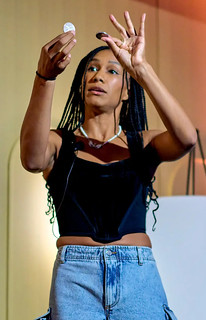 For now, though, being a woman in magic can be a lonely pursuit. Take Nicole Cardoza, who often says she is the
For now, though, being a woman in magic can be a lonely pursuit. Take Nicole Cardoza, who often says she is the only Black female magician I know.
Ms. Cardoza, 34, who specializes in coin magic, or coin production, has been touring the country for more than two years, performing at universities, churches and conferences. Onstage, she is equal parts storyteller, teacher and magician in shows that reference and evoke Ellen Armstrong, who is believed to be the first Black woman to have a touring magic show in the 1900s.
As she pulled one coin and then another out of thin air during a performance at a church in Brooklyn earlier this year, she told the audience, Sometimes we need to believe in things before we can see them.


